Shopping in India (Part 2)
(Ja, da war doch noch was… ich habe es nicht vergessen…..) Stellt sich also die Frage, wie das so abläuft, wenn die Ware nicht frei zugänglich in Regalen liegt. (Meine Erfahrung bezieht sich hauptsächlich auf Textiles, ich denke aber, bei anderen Artikeln ist es letztlich ähnlich.)
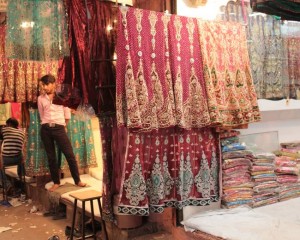 (No, I didn’t forget… just took some more time…) So, you have no shelves where you can pick things yourself, you have not price tag… how to proceed? (My experience is mostly based on textile items, but I think it will be similar with other things.)
(No, I didn’t forget… just took some more time…) So, you have no shelves where you can pick things yourself, you have not price tag… how to proceed? (My experience is mostly based on textile items, but I think it will be similar with other things.)
Zunächst braucht man eine ungefähre Vorstellung, was man überhaupt will. Sari, Schal, Kurta,… man kann auf Bazaren und in den Ladenstraßen natürlich an den Läden vorbei schlendern und schon mal so ungefähr gucken, was es so gibt und wo es einem vielleicht gefallen könnte. Allerdings muß man meist sehr schnell gucken, denn sobald man stehen bleibt wird man auch rasch angesprochen, besonderns an Orten mit vielen Touristen. Wenn man tatsächlich was kaufen will, ist das natürlich gut. Andernfalls eher lästig, aber man kann jederzeit weiter gehen.
First thing is that you need to know what you want. Saree, shawl, kurta,..? If you stroll through bazaar streets you can check what the shops have hanging outside and what might be to your liking. Usually you have to look fast, because as soon as you stop the shop owner might talk to you. That the more often the more tourists a place holds. If you xonsider to buy at that shop that is fine, if not… well you can always walk on. No obligation!
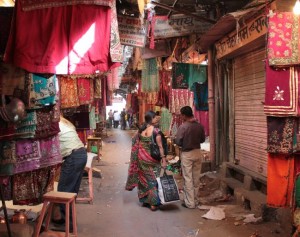 Bevor man einen Laden betritt empfiehlt sich ein Blick auf den Boden. Oft ist das eine mit hellem oder weißen Stoff bedeckte Fläche oder Plattform auf der Leute herumsitzen oder -stehen. Diese Leute sind dann meist barfuß. In diesem Fall zieht man dann seine eigenen Schuhe auch aus. (Was man in Indien ohnehin im Haus generell macht.) Da findet sich auch fast immer irgendwo eine Matte, wo man sie hinstellen kann.
Bevor man einen Laden betritt empfiehlt sich ein Blick auf den Boden. Oft ist das eine mit hellem oder weißen Stoff bedeckte Fläche oder Plattform auf der Leute herumsitzen oder -stehen. Diese Leute sind dann meist barfuß. In diesem Fall zieht man dann seine eigenen Schuhe auch aus. (Was man in Indien ohnehin im Haus generell macht.) Da findet sich auch fast immer irgendwo eine Matte, wo man sie hinstellen kann.
Before you enter a shop better have a look on the floor. If it is covered with white fabric or similar and people are sitting and standing on it then have a look at the feet of those people. If they are barefoot then take off your shoes or sandals before you enter (that is hardly ever wrong if you enter a house or a flat in India). Often there is a mat or something close to the entrance to leave your shoes on it.
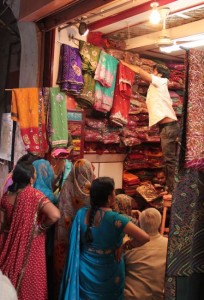 Wenn man ungefähr sagen kann, welche Farben oder Muster man sucht ist das gut, wenn nicht ist es aber nicht schlimm. Der Händler wird die Saris, Stolen, Stoffe,… vor einem ausbreiten in schneller Folge. Wenn man etwas genauer angucken will, dann muß man sich entsprechend bemerkbar machen. Was gar nicht in Frage kommt, das lehnt man gleich ab. So werden die Vorschläge auch passender. Wenn einem was besonders gut gefällt, dann kann man das auch gleich sagen. Wenn man genug gesehen hat, dann sagt man das auch. Meist liegt dann ein großer Haufen vor einem. In dem Fall nimmt der Verkäufer dann einen nach dem anderen wieder weg und man meldet sich, welche man eventuell behalten will. So wird Stück für Stück die Auswahl kleiner bis man am Ende bei dem oder den Stücken angekommen ist, die man gerne kaufen würde.
Wenn man ungefähr sagen kann, welche Farben oder Muster man sucht ist das gut, wenn nicht ist es aber nicht schlimm. Der Händler wird die Saris, Stolen, Stoffe,… vor einem ausbreiten in schneller Folge. Wenn man etwas genauer angucken will, dann muß man sich entsprechend bemerkbar machen. Was gar nicht in Frage kommt, das lehnt man gleich ab. So werden die Vorschläge auch passender. Wenn einem was besonders gut gefällt, dann kann man das auch gleich sagen. Wenn man genug gesehen hat, dann sagt man das auch. Meist liegt dann ein großer Haufen vor einem. In dem Fall nimmt der Verkäufer dann einen nach dem anderen wieder weg und man meldet sich, welche man eventuell behalten will. So wird Stück für Stück die Auswahl kleiner bis man am Ende bei dem oder den Stücken angekommen ist, die man gerne kaufen würde.
If you can tell what patterns or colors you are looking for that is great, if not, the vendor will choose what he thinks you might like. Often he will unfold one saree, shawl,… after the other, often quite quickly. If you want to check something longer you just tell him. If you know for sure you do not like something tell right away, that will help the vendor to make you more fitting offers. If you like something quite a lot tell him also. Usually you end up with a big heap of stuff in front of you. No problem, the second round will be taking away one after the other until you have finished your selection and know which piece or pieces you’d like to buy.
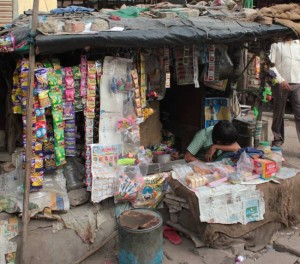 Dann kommt natürlich die Preisfrage. Was die Sachen für indische Verhältnisse „wert“ sind ist immer schwer zu sagen. Zumal das auch von Gegend zu Gegend abweicht. Letztendlich kann man sich nur auf das eigene Gespür verlassen. Ich überlege einfach pragmatisch, was es mir persönlich wert ist. Natürlich ist in Indien vieles billiger als bei uns, Andererseits gilt auch hier: wenn ein Preis zu gut ist, um wahr zu sein, dann ist er nicht wahr. Ein „Pashmina“ für 100 Rupien hat auch in Indien Kaschmir nicht mal aus der Ferne gesehen sondern ist aus Viscose oder Kunstfaser. Und für 600 – 1000 Rupien kann man eine schöne bestickte Wollstola bekommen, aber kein Kaschmir. Natürlich wissen die Händler, welche Begriffe „ziehen“, ob die Seide tatsächlich Seide ist… da muß ich mich auf meine eigenen Augen und Finger verlassen. Egal was der Händler mir versichert, ich bilde mir selber ein Urteil und überlege mir dann, was die Sachen mir wert sind. Das ist mein Preislimit. Da wir als Europäer deutlich reicher sind als der durchschnittliche Inder kann ich damit leben, oft mehr zu zahlen. Auf der anderen Seite sind Luxusgüter wie aufwendig gewebte Saris oder Goldstickerei in Indien nur einer sehr begüterten Minderheit vorbehalten und die ist oft wirklich reich. Auch für europäische Verhältnisse.
Dann kommt natürlich die Preisfrage. Was die Sachen für indische Verhältnisse „wert“ sind ist immer schwer zu sagen. Zumal das auch von Gegend zu Gegend abweicht. Letztendlich kann man sich nur auf das eigene Gespür verlassen. Ich überlege einfach pragmatisch, was es mir persönlich wert ist. Natürlich ist in Indien vieles billiger als bei uns, Andererseits gilt auch hier: wenn ein Preis zu gut ist, um wahr zu sein, dann ist er nicht wahr. Ein „Pashmina“ für 100 Rupien hat auch in Indien Kaschmir nicht mal aus der Ferne gesehen sondern ist aus Viscose oder Kunstfaser. Und für 600 – 1000 Rupien kann man eine schöne bestickte Wollstola bekommen, aber kein Kaschmir. Natürlich wissen die Händler, welche Begriffe „ziehen“, ob die Seide tatsächlich Seide ist… da muß ich mich auf meine eigenen Augen und Finger verlassen. Egal was der Händler mir versichert, ich bilde mir selber ein Urteil und überlege mir dann, was die Sachen mir wert sind. Das ist mein Preislimit. Da wir als Europäer deutlich reicher sind als der durchschnittliche Inder kann ich damit leben, oft mehr zu zahlen. Auf der anderen Seite sind Luxusgüter wie aufwendig gewebte Saris oder Goldstickerei in Indien nur einer sehr begüterten Minderheit vorbehalten und die ist oft wirklich reich. Auch für europäische Verhältnisse.
Next question is the price. What the „value“ under Indian conditions is ist often hard to tell. It also differs from region to region. At the end you can only relay on yourself. If a price is to good to be true then usually it isn’t true. A „pashmina shawl“ for 10 rupies hasn’t seen a cashmere goat from far and will be made of viscose or poly fiber. for 600 – 1000 rupies you can have a beautifully embroidered shawl of soft wool or a woll and silk blend, but not cashmere. The shop owners of course know, what tourists (and Indians) want to hear, so they will offer it as such. So no matter what the vendor tells me, my hands any my eyes will be my main reference. And then I make up my mind what it is worth for me. That will be my price limit. I can live with the fact that tourists often pay more than Indians, I have far more money than the average Indian. On the other side tourists often buy luxury goods like complicated silk weaves or gold embroidery that only very rich Indians can afford and those will have far more money than most of the tourists.
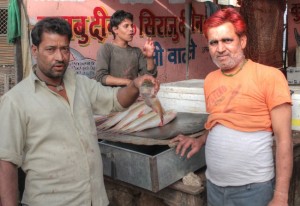 Ja und der Rest ist eigentlich ganz einfach…
Ja und der Rest ist eigentlich ganz einfach…
Man fragt nach dem Preis. Wenn man mehrere Dinge hat, dann nicht pro Stück, sondern für das ganze „Paket“. Danach erst mal nix sagen, warten und freundlich lächeln bringt meist schon die ersten 7% – 10% Reduktion. Dann macht man ein freundliches Gegenangebot. Mutige Naturen bieten die Hälfte oder weniger, 30 Prozent unter dem Angebot kann man auf alle Fälle einsteigen. (Kommt auch drauf an, wo das Angebot des Verkäufers liegt.) Mehr muß nicht sein. Dabei geschieht alles in einer freundlichen Atmosphäre. Es ist klar, ich will es kaufen, er will es verkaufen, wir reden nur noch über den Preis. Keine Drohung „ich kaufe nicht wenn nicht…“, sondern im Grunde sind wir uns einig. Und so geht das dann ein paar Mal hin und her, bis man sich auf einen Preis geeinigt hat. Finde ich den Preis unangemessen hoch zeige ich das dadurch, das mein erstes Gegenangebot bei 10 Prozent von der geforderten Summe liegt. Entweder das Gespräch ist dann beendet, dann kommen wir eben nicht zusammen oder der Händler geht gewaltig runter. Wichtig ist, daß das erste eigene Angebot deutlich unter dem liegt, was man zu zahlen bereit ist. Denn treffen wird man sich irgendwo dazwischen. (20% – 25% unter dem ersten Händlerangebot sind eigentlich immer drin. Zumindest bei mir. Meine indische Freundin zahlt oft höhere Preise als ich, weil sie nicht gerne handelt. :o) )
The rest is easy…
You ask for the price. If you have several items you’ll ask the price for the whole „package“, not the single items. After the first offer you say nothing, just look friendly and expectantly. That often brings the first 7%-10% reduction. Then you make your couneroffer. It the first offer ist not completely unrealistic and far from your own limit you might offer 30 % less. If you are more courageous you offer 50%. All that happens in a friendly atmosphere. You are basically willing to buy the articles, you are just talking about the conditions. So it will go back and forth several times until the price is set. If I think the price is way to hight I will show it by only offering 10 % of the sum the vendors sets in his first attempt. Either we are finished there quickly, so we both did not loose time or the next offer will be better. Important thing is to offer less than what you are willing to pay, you need room to bargain. (I usually get at least 20% – 30% off the first offer. Often I pay less than my Indian friend, because she does not like bargaining. :o) )

Die bis zur Decke aufgehängten Stoffe und Kleider – auch in den Gassen – erinnern an den Souq in Jerusalem.
Und auch in Israel und Jordanien war es schwierig zu erkennen, ob ein Preis gerechtfertigt war.
Sehr schöner Bericht! Da kommen bei mir Erinnerungen hoch an meine Reise nach Pakistan. Muss allerdings zugeben, dass ich überhaupt nicht gut im Handeln bin und vermutlich weit über dem Durchschnittspreis bezahlt habe. Aber was solls! Ich habe dort so schöne, unvergessliche Momente erlebt, dass mir das den Preis wert war. Trotzdem hilfreiche Tipps… sozusagen das 1×1 des Handelns für ahnungslose Touristen. Daumen hoch!